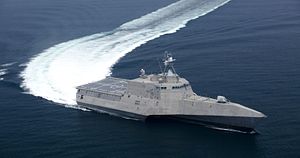The U.S. Navy’s program officer for the Littoral Combat Ship (LCS) announced plans to simultaneously deploy two of the ships to Singapore in 2018. Speaking to the independent U.S. Naval Institute News, Rear Admiral John Neagley said the U.S. Navy is working on the maintenance, logistics, and training requirements to support two ships in Singapore simultaneously; so far LCS units have only deployed there individually. The U.S. Navy originally hoped to have four LCSs in Singapore by now, a plan thwarted by significant manning and maintenance challenges in the LCS deployments to-date.
In 2015, the U.S. Admiral in charge of the Singapore-based Task Force 73 told reporters that the U.S Navy planned to rotationally deploy four LCS units there by as early as May 2017, and at least by 2018. As May of 2017 came and went, the new, more modest goal articulated by Admiral Neagley reflects the lessons the U.S. Navy has learned from earlier breakdowns that have sidelined each of the previously deployed LCSs.
The LCS rotational deployment concept is unique. As originally conceived, a ship would be deployed overseas for about eighteen months, during which time three separate crews would rotate through at four-to-six month intervals. The small size of the LCS’s crew, only one third of what a traditionally-crewed ship of similar size would have, meant that each crew required extensive additional training to be able to fill multiple roles and jobs.
Three LCSs have deployed to Singapore since 2013, each experiencing major challenges. As the first LCS to deploy, the USS Freedom, had many “first in class” problems and maintenance issues, and the crew was found to be overworked and under-supported. The USS Fort Worth sustained a major casualty to its propulsion system that kept it out of action in Singapore for nearly six months before sufficient repairs were completed to allow it to return to the United States.
The USS Coronado suffered its own propulsion casualty while still en route to Singapore, forcing it to return to Hawaii for a month of repairs. Once in Singapore, major changes to the LCS crew concept and training pipeline to address some of the earlier high-profile problems meant that the follow-on crew was severely delayed, and crew that took the ship from the United States to Singapore ended up having to spend nine months on board instead of four or five.
Nevertheless, the U.S. Navy sees the LCS as an important asset for the United States in Southeast Asia. Admiral Neagley highlighted that the LCS’s shallow draft and smaller size allowed it to access more ports than most other U.S. warships, making it ideal to conduct security cooperation with regional navies.
But while the U.S. Navy see’s the LCS’s role primarily in regional patrols and bolstering cooperation with partner navies, as China’s military presence and reach in the South China Sea has put the LCS’s relatively light armament into relief, particularly its lack of missiles for use against ships or aircraft. When the USS Forth Worth patrolled the South China Sea in May 2015 it was reportedly “stalked” by a more-heavily armed Chinese frigate, and when it returned to the South China in July it was partnered with a destroyer, the USS Lassen.
Some of the LCS’s lack of capability is slated to be addressed through upgrades requested as unfunded priorities, including anti-submarine warfare equipment, improvements for existing air-defense missile systems, and preparing space to eventually install an anti-ship missile system. But as the term implies, there is no guarantee that funds will be appropriated to complete the work.
The reforms to the LCS program that delayed the USS Coronado’s crew included reducing the number of rotational crews from three to two and increasing the crew-size, and improving its maintenance and training support, suggesting that the U.S. Navy is well-positioned to finally achieve its goal to sustain multiple LCSs in Singapore next year. As the efforts to improve the LCS’s lethality progress and the U.S. Navy considers how to transition from the LCS to a far more capable frigate-type small combatant in the next few years, the groundwork is being laid to keep a persistent and increasingly capable presence in the South China Sea that can work effectively with partner navies in the region and that also has credible combat power to deter potential aggression.































